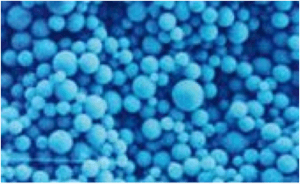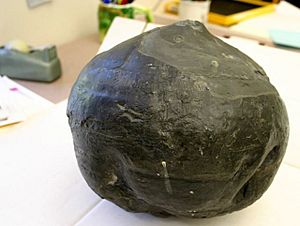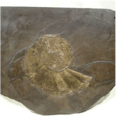Permineralization facts for kids
Permineralization is a cool way that fossils are made! It happens when minerals from water fill up the empty spaces inside dead plants or animals. Imagine pouring liquid concrete into a sponge – the concrete fills all the holes, and when it hardens, you have a solid shape of the sponge. Permineralization is a bit like that, but with minerals and ancient organisms!
This process helps us learn a lot about how ancient life looked, even showing details of soft parts that usually decay away. Scientists can study these fossils to understand the inside structures of plants and animals from millions of years ago.
Contents
How Permineralization Works
When an organism dies, it might get buried in mud, sand, or volcanic ash. Water from the ground, lakes, or oceans then slowly seeps into its tissues. This water carries tiny bits of dissolved minerals. As the water moves through the organism's cells, these minerals start to settle and form crystals.
First, the crystals grow in the tiny holes and spaces within the cell walls. Then, they continue to fill up the larger central part of the cell, called the lumen. Eventually, the entire cell becomes completely filled with minerals. The original cell walls often stay in place around these new mineral crystals.
It's important to know that permineralization is different from petrification. In petrification, the original organic material is completely replaced by minerals. But in permineralization, the original material is just filled with minerals, not totally replaced.
Different Types of Permineralization
Permineralization can happen with different kinds of minerals. Here are some of the most common types:
Silicification
This is the most common type of permineralization. It happens when the minerals that fill the organism's tissues are made of silica. Silica is the main ingredient in sand and quartz. Many amazing fossilized trees, often called "petrified wood," are formed this way.
Carbonate Mineralization
Carbonate mineralization happens when minerals like calcium carbonate (the stuff in seashells and limestone) fill the spaces. A great example of this is Coal balls. Coal balls are special fossils of plants and their tissues. They usually form when plants are buried in seawater or in acidic peat bogs. These fossils are super useful for learning about plant life from the Upper Carboniferous period, which was about 325 to 280 million years ago.
Pyritization
Pyritization occurs when organisms are buried in marine sediments that are full of iron sulfides. These minerals then fill the organism's tissues, turning them into a shiny, metallic fossil. This often gives the fossil a golden or brassy look, because iron sulfide is also known as "fool's gold" (pyrite).
Images for kids
See also
 In Spanish: Permineralización para niños
In Spanish: Permineralización para niños





